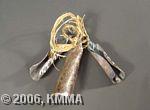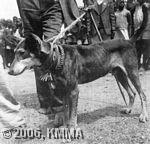


The umudende belongs to the group of narrow cylindrical bells and is the only one of its kind still used in Rwanda. Proof that it is a very old instrument is furnished by Van Noten in his study of the offerings buried in the tomb of Cyirima II Rujugira.
The umudende is formed by bending a thin iron sheet into a narrow cylinder (9-14 cm in length and 1.8-2.5 cm in diameter) that narrows towards the top like a funnel. At the top of the sheet is a narrow projecting tongue of metal that is folded inwards, forming a hook for the narrow clapper (6-10 cm). The organological collection of the Institute of Scientific and Technological Research (IRST) in Butare, Rwanda, contains slightly larger examples, catalogued under the name umudende w’inka, or ‘umudende of the cow’.
Another variant is the smaller ikirangajana, a purely ritual instrument. The ikirangajana is also symbolically worn, together with an inzogera, by people and animals if they have achieved a multiple of seven in a particular aspect of their lives: women who give birth to a seventh child, hounds who catch their seventh quarry, warriors who take part in their seventh battle, etc. In their way of thinking seven stands for blindness and to protect themselves against it, they wear these – magically charged – instruments. Wearing an umudende also confers a certain prestige of course and therefore serves to make the wearer stand out. Women and cows wear it as an amulet, while for men and hounds the purpose is to emphasise their courage.
For more information consult the following publications edited by the RMCA:
© KMMA/Jos GANSEMANS